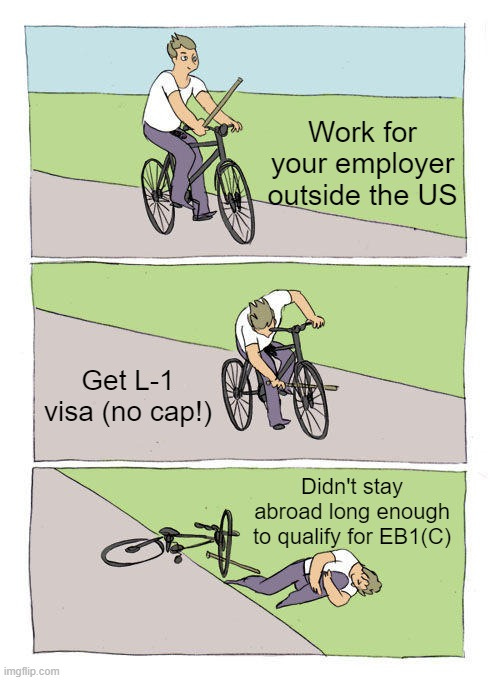Current Trends in EB Immigration (Oct 30, 2022)
This post provides a high level summary of some of the current trends in Employment -Based (EB) immigration. It is written for someone with relatively advanced understanding of issues.
This post covers current trends in Employment-Based (EB) immigration, as of the end of October 2022, in the following areas -
01. H-1Bs.
02. L-1s.
03. Other non-immigrant visa categories (O-1s and TNs).
04. Visa stamping/international travel.
05. PERM.
06. PERM-exempt I-140s.
07. Adjustment of Status/Visa Bulletin.
This post is written for someone with relatively advanced understanding of issues meaning there is a fair amount of jargon. The information here is based largely on anecdotal information - my own cases and cases of my friends or professional acquaintances.
Please post your questions and comments, and/or whether your own experiences differ from what I mention here!
01. H-1Bs.
The Biden Administration’s USCIS continues to handle H-1Bs relatively efficiently, as compared to how H-1B adjudications were handled by the Trump Administration. While there are occasional RFEs (Requests for Evidence) on specialty occupation issues for initial filings, H-1B extensions are generally given deference, and USCIS adjudicators seem to have given up on the bizarre treatment of Computer Systems Analysts. There is less push back on consulting firms and related “employer/ employee” issues although those issues sadly remain alive and well at U.S. consulates.
Premium processing H-1Bs are being reviewed extremely quickly, often in 5 days.
Premium processing H-1Bs filed concurrently with H-4 and H-4 EADs are seeing quick approvals of the I-539 (H-4) and I-765 (H-4 EAD). Some H-4 EADs are coming through just a couple weeks after the H-1B is approved.
Although interest rates are rising in the United States, which is impacting the housing market and earnings at major tech companies (many of whom are doing layoffs), the U.S. economy overall seems strong and unemployment is low. These facts, combined with a more favorable adjudication environment, suggest the H-1B cap lottery in March 2023 will likely be a new record, meaning that employers and candidates hoping for cases being chosen in the H-1B cap lottery need to prepare themselves for low odds.
The cottage industry of “speculative employers” seems alive and well and the Biden Administration could probably do more to crack down on them. There is a real risk that “speculative employers” will flood the H-1B cap lottery system in March 2023.
02. L-1s.
There is a lot of interest in L-1s given the low unemployment rate in the United States and the difficulty in finding qualified people to fill job openings.
Blanket L processing continues to be much easier than individual L-1s filed at USCIS. Employers with at least $25 million in top line revenue as documented by a U.S. income tax return should really be considering obtaining a corporate blanket petition if they don’t have one already.
The USCIS under Biden, as they did under Trump, and before that under Obama, continues to issue a lot of RFEs on both individual L-1A cases and individual L-1B cases. I think there is an ongoing debate among immigration professionals on whether you try to make an initial filing for individual L-1 “RFE-proof” by spending a lot of time on the front end, or just resign yourself to a RFE and get the thing filed, planning to deal with the RFE later.
Indian-born candidates in particular are increasingly interested in L-1A and EB1(C) immigration options, including candidates who were not chosen in the H-1B cap lottery. But going abroad and returning on L-1A and being eligible for EB1(C) require careful consideration and I don’t think all the situations are as well-considered as they should be. To qualify for EB1(C), keep in mind the candidate must be a manager abroad and for the proposed position in the US. It may be prudent for a candidate to stay abroad long enough to qualify as a manager, that is, work at least 12 months as a manager abroad before being transferred back to the US.
03. Other non-immigrant visa categories (O-1s, TNs, Etc.).
O-1 petitions are filed either at the USCIS California Service Center (CSC) or in Vermont, based on where the petitioner’s headquarters is based. CSC continues to demonstrate reasonable adjudication standards while VSC continues to push back on O-1 petitions, even for beneficiaries with extremely strong credentials. I have heard that Harvard University is reluctant to file O-1 petitions given how hostile VSC is.
TNs seem to be incredibly popular, with Mexicans who qualify in particular finding lots of opportunities. One potentially problematic trend to watch is possible abuses of TNs where Mexicans are being hired into TN occupations but then serving in roles that are inconsistent with the TN offer letter and the TN professional category identified. Because TNs don’t have an annual limit on visas (like the H-1B cap) and there is no prevailing wage requirement, the possibility of abuses has always been there but it seems like there are more people ‘pushing the envelope.’
04. Visa stamping/international travel.
It continues to be very difficult to obtain visa appointments at U.S. consulates worldwide but after many news stories shining a light on this problem, it does seem the U.S. Department of State has added resources/staff and is at least acknowledging the problem.
The U.S. Department of State headquarters has made clear that “third country national” processing should be possible and there are more and more stories of people processing as TCNs. Indians are going to Fiji and Bosnia, two places where appointments are relatively easy to get (fast) and there is no entry visa requirement. But some U.S. consulates continue to state on their websites that TCN processing is not possible.
The U.S. consulates in India continue to add both interviews and drop-box appointments but one frustrating trend in India is the extreme rise in 221g administrative processing notices issued to Indian H-1B visa holders. The 221g delays complicate H-1B workers being able to return to the US in a timely way, after they have spent a lot of time and money trying to get their visa stamping done.
Plan ahead and be flexible about international travel.
People who do a lot of travel, domestically and/or internationally, should be looking into Global Entry to facilitate faster clearing of U.S. Customs and TSA Precheck for domestic U.S. travel.
05. PERM.
PERM is very slow - both for the 9141 prevailing wage requests and the 9089 PERM application processing time. There is no indication that DOL is going to do anything about it and there is every reason to believe things will GET SLOWER as we get into 2023.
More and more employers are open to filing PERM applications for skilled workers (and even some unskilled workers), skipping temporary visas and going straight to a green card.
06. PERM-exempt I-140s.
Because PERM is slow, more employers and candidates are looking at PERM-exempt options particularly EB-2 NIW. F-1 students from India and China are looking at EB-1A as an option to mitigate the challenges of the H-1B cap.
The Biden Administration has issued policy guidance to promote EB-2 NIW and also O-1. This guidance does seem to help.
Separately, EB-2 NIW petitions are now often approved in a matter of weeks or just a few months.
EB-1A and EB-1B adjudications continue to be fairly strict, with the Nebraska Service Center generally stricter than Texas.
07. Adjustment of Status/Visa Bulletin
USCIS continues to use local field offices to adjudicate EB I-485 applications, and this continues to result in relatively fast processing. The local office adjudicators also seem to be extremely reasonable on other issues like documenting maintenance of status and/or birth certificates.
But because so many EB I-485 applications are being approved, there is concern that cut-off dates will appear for ROW (Rest of World).
Sadly, EB2 and EB3 India cut-off dates have retrogressed and are not likely to move up quickly. I had hoped we would see forward movement by January but now I am less certain.
CONCLUSION
I hope this summary of trends has been useful. In an upcoming post, I hope to provide ideas on how to mitigate the current trends, and how those of us in the EB immigration world should be preparing for a possible recession in 2023.
Thanks for reading this far!





